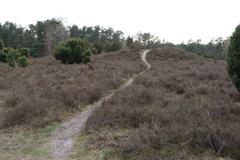
Comprehensive Guide to Visiting Grundloses Moor, Walsrode, Germany
Date: 24/07/2024
Introduction
Grundloses Moor, located in Walsrode, Germany, is a natural marvel that has captivated the interest of both scientists and nature enthusiasts. This peat bog, formed over 10,000 years ago during the last Ice Age, stands as a testament to the Earth’s geological and ecological history. As glaciers retreated, they left behind depressions that filled with water, creating the perfect conditions for the formation of peat bogs like Grundloses Moor. The accumulation of dead plant material, particularly sphagnum moss, over millennia has led to the development of this unique and complex ecosystem (Wikipedia).
Beyond its geological significance, Grundloses Moor holds historical importance for the local population. Peat, harvested from the bog, was a vital resource for heating and cooking before the widespread use of coal. Today, the moor is a living archive, preserving biological and archaeological data that offer insights into past climates, vegetation, and human activities (Hiiker).
Ecologically, Grundloses Moor is home to a diverse array of plant and animal species uniquely adapted to its acidic, nutrient-poor conditions. This includes rare and endangered species like sundews and bladderworts, as well as important flora such as sphagnum moss and cottongrass. The moor also acts as a significant carbon sink, playing a crucial role in climate change mitigation by storing large amounts of carbon dioxide (Lüneburger Heide).
For visitors, Grundloses Moor offers a unique experience with well-maintained walking trails, guided tours, and educational programs. It is part of the Lüneburg Heath Nature Park, a protected area dedicated to conserving the region’s natural and cultural heritage. Whether you’re a nature lover, a history buff, or simply looking for a tranquil escape, Grundloses Moor provides a rich and rewarding visit.
Table of Contents
- Introduction
- History and Formation of Grundloses Moor
- Ecological Importance
- Preservation Efforts
- Visitor Experience
- Conclusion
History and Formation of Grundloses Moor
Geological Formation
Grundloses Moor is a type of peat bog, a wetland area that accumulates peat, a deposit of dead plant material—often mosses, particularly sphagnum moss. The formation dates back to the last Ice Age, approximately 10,000 years ago. As glaciers retreated, they left behind depressions that gradually filled with water, creating ideal conditions for peat bog formation. The depth of peat in Grundloses Moor can reach several meters, indicating thousands of years of accumulation.
Historical Significance
Historically, peat was a crucial resource for the local population, used as a fuel source for heating and cooking before coal became widely available. The practice of peat cutting, known as ‘turf cutting,’ has left its mark on the landscape. Grundloses Moor has also been a site of scientific interest, preserving biological and archaeological information that offers insights into past climates, vegetation, and human activities (Hiiker).
Ecological Importance
Peat bogs like Grundloses Moor support a variety of plant and animal species adapted to the acidic, nutrient-poor conditions. The moor is home to rare and endangered species, including carnivorous plants like sundews (Drosera) and bladderworts (Utricularia). Peat bogs are significant carbon sinks, storing large amounts of carbon that would otherwise be released as carbon dioxide, thus playing a crucial role in climate change mitigation.
Preservation Efforts
Grundloses Moor is part of the Lüneburg Heath Nature Park, a protected area aiming to conserve the region’s natural and cultural heritage. Conservation efforts include preventing drainage and degradation and restoring damaged areas. Public awareness and education are key components, with informational displays and guided tours fostering a sense of stewardship and encouraging sustainable tourism practices (Wikipedia).
Visitor Experience
Visiting Information
For those planning to visit Grundloses Moor, it is accessible via well-maintained walking trails. Visitors should stay on designated paths to avoid disturbing the sensitive ecosystem. The moor’s unique conditions require sturdy, waterproof footwear and appropriate weather clothing.
- Visiting Hours - Grundloses Moor is open year-round, but it is advisable to check specific hours on the Lüneburg Heath Nature Park website.
- Tickets - Entry is typically free, but guided tours may have associated costs. Check the official website for the latest information.
- Accessibility - The trails are generally accessible, but the soft, waterlogged ground may present challenges for those with mobility issues.
- Nearby Attractions - Visitors can also explore other attractions in Walsrode, such as the Walsrode Bird Park and the Lüneburg Heath Nature Park.
Guided Tours and Special Events
Guided tours provide valuable insights into the history, ecology, and conservation of Grundloses Moor. These tours are led by knowledgeable guides who can answer questions and share fascinating stories. Special events and educational programs are also periodically offered (Lüneburger Heide).
FAQ
- What are the visiting hours for Grundloses Moor? Grundloses Moor is open year-round. Check the Lüneburg Heath Nature Park website for specific hours.
- How much are tickets to Grundloses Moor? Entry is typically free, but guided tours may have associated costs.
- What should I wear when visiting Grundloses Moor? Sturdy, waterproof footwear and weather-appropriate clothing are recommended.
- Are there guided tours available? Yes, guided tours are available and provide valuable insights into the moor’s history and ecology.
Conclusion
Grundloses Moor in Walsrode, Germany, is a remarkable natural site with a rich history and significant ecological value. Its formation over thousands of years, historical importance, and role in carbon sequestration make it a site worth preserving and exploring. By following visitor guidelines and supporting conservation efforts, tourists can enjoy and help protect this unique landscape for future generations.
Grundloses Moor stands as a beacon of natural beauty, historical significance, and ecological importance. It is a testament to the intricate balance of nature and the enduring legacy of our planet’s history.
For more information on visiting Grundloses Moor, you can check the Lüneburg Heath Nature Park website.




